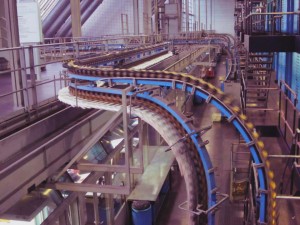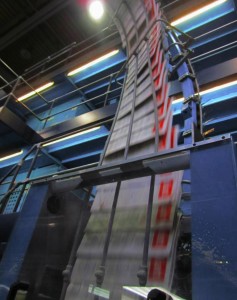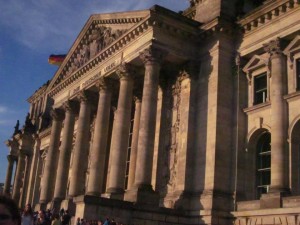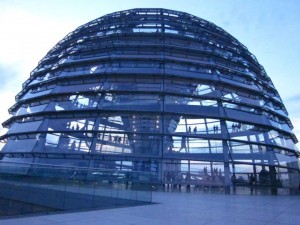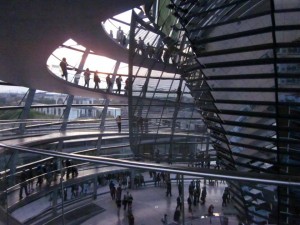by Alexa Blanchard
In the world of advertising, he who generates the most profit is king. But for Süddeutsche Zeitung, a quality national newspaper located in southern Germany, innovation is the key to success.
Generating revenue through ad space is extremely important for a print newspaper, as the only other source for money-making relies on subscriptions. But with the universal decline in print, how do papers like Süddeutsche Zeitung keep their advertisers buying space? How do they keep their readers coming back for more?
Michael Stengl, the product manager of advertisements, was eager to showcase Süddeutsche Zeitung’s unique advertising methods to Point Park University’s International Media class. The group of Pittsburgh students was comprised of communications majors of all varieties, including advertising and journalism majors. For most, this exclusive inside look at the functionality of a newspaper and their advertisements is especially relevant.
BMW, or Bavarian Motor Works, purchases a lot of ad space from Süddeutsche Zeitung. Stengl demonstrated some of the work that has put together to show of BMW’s luxury vehicles.
“We wondered, ‘how can we reach our audience with bigger, poster-sized images?’” Stengl inquired, citing the effectiveness of large billboard images that are exposed to the public.
He ended his rhetorical question by turning a page in his demonstration newspaper and revealing a true poster-sized image of a new BMW model, an ad that spanned across two newspaper pages. It was truly larger than life, compared to the commonplace ads that typically take up one quarter of a page to one half to a full page at most. Two entire pages for one ad are brilliant and unheard of in most U.S. newspapers except for the largest, such as The New York Times.
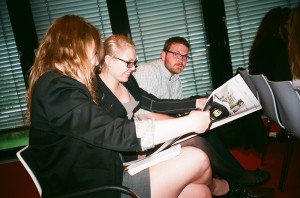
Alexa Blanchard and Johnie Freiwald check out a special advertisement in the pages of Munich’s Sueddeutsche Zeitung.
(photo by Helen Fallon)
Stengl passed around several other innovative advertising techniques that Süddeutsche Zeitung has employed, including a scented ad and a multi-sensory ad.
“We published this [multi-sensory] ad for BMW and our competitors called us and said ‘What have you done? This is brililiant,’” Stengl added.
The multi-sensory ad in question details driving a BMW from a chauffer’s perspective. The open road ahead is glossed with UV detailing, and the dashboard of the car actually feels like how a real dashboard would. Readers can touch the steering wheel and feel the texture of leather underneath their fingers, and the sleeves of the chauffer are outlined with cloth. This ad is multi-sensory because readers use not only their eyes, but also their sense of touch. Perhaps they even have a smell.
It encourages the reader to stop and take a moment to interact with an advertisement, something that had never been done before. More than anything, it makes the reader remember. Many will never forget that this two-page spread with a tangible leather steering wheel was an ad for BMW, and that they saw it – felt it – in Süddeutsche Zeitung. This is the kind of interactivity, innovation and notoriety that the paper is going for, Stengl said.
Still reeling from the never-before-seen advertising, the Point Park students were then treated to yet another inside look across the street at Süddeutsche Zeitung’s printing presses. The printing process, which begins at 6 o’clock each evening, is a mammoth undertaking with an innumerable amount of moving parts, employees and equipment working around the clock to get the job right and ready for delivery.
The presses, spanning multiples floors and reaching far and wide, print the broadsheet newspaper at breakneck speed and push their respective paper sections onto conveyor belts where they are mechanically assembled and frequently checked for color. If the color, layout, or printing angle is incorrect then those batches of papers will be trashed and the process corrected. Advertising inserts – a huge source of revenue for the paper – are automatically inserted. The presses are so automated that mailers and inserters are no longer employed, and a small staff of printers is needed, which saves the company money.
All of this must be done in a matter of hours to satisfy the demand of the paper, which has one of the highest circulations in Germany with over 1.1 million daily readers, not including its international demand. The presses generate about 36,000 papers per hour, according to Stengl, and run all night until pickup in the morning.
All of this combined for what Stengl sees as a bright future for Süddeutsche Zeitung, which experienced extreme financial difficulty in the economic fallout in 2007-2008 and placed it on the brink of bankruptcy. Printing a quality newspaper and publishing books and other projects have set the paper on a sound financial course, as well as reaching out with new technological ventures.
And the paper remembers its near collapse as it moves forward. “Print has a future,” Stengl said. “But it must be interesting [to current and future readers].”
